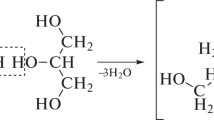Abstract
The present work is devoted to studies of the rheological properties of sol–gel systems based on tetraethoxysilane by the falling ball method developed by F. Höppler. The systems under study were modified by organic polyols of linear, branched, and hyperbranched structures and inorganic boron and gadolinium dopants. The parameters of viscosity and strength of the network of the formed organic-inorganic composite, which are important characteristics of sol–gel systems properties, have been presented. The data characterizing the range of permissible concentrations of organic components introduced into a system to improve the synthesized films properties have been demonstrated.
Similar content being viewed by others
References
Khimicheskie metody polucheniya keramicheskikh i polimernykh nanomaterialov iz zhidkoi fazy: Uchebnoe posobie (Chemical Methods for the Preparation of Ceramic and Polymer Nanomaterials from the Liquid Phase: A Textbook), Luchinin, V.V. and Shilova, O.A., Eds., St. Petersburg: St. Petersburg State Electrotechnical University “LETI”, 2013.
Shilova, O.A., Synthesis and structure features of composite silicate and hybrid TEOS derived thin films doped by inorganic and organic additives, J. Sol–Gel Sci. Technol., 2013, vol. 68, no. 3, pp. 387–410.
Smirnova, I.V., Shilova, O.A., and Bubnov, Yu.Z., Investigation of the parameters of layers prepared through diffusion of boron and gadolinium from silicate and hybrid films into silicon wafers, Glass Phys. Chem., 2009, vol. 35, no. 1, pp. 102–111.
Smirnova, I.V., Shilova, O.A., Moshnikov, V.A., and Gamarts, A.E., Features of simultaneous diffusion of boron and gadolinium in silicon from nanoscale hybrid organicinorganic films, Semiconductors, 2009, vol. 43, no. 10, pp. 1394–1399.
Shilova, O.A., Silicate nanosized films prepared by the sol–gel method for use in planar technology for fabricating semiconductor gas sensors, Glass Phys. Chem., 2005, vol. 31, no. 2, pp. 201–218.
Petrova, I.V., The sol–gel technology of silicate and hybrid films—sources of the diffusion of boron and gadolinium into silicon, Molodoi Uchenyi, 2014, no. 10, pp. 46–53.
Maksimov, A.I., Moshnikov, V.A., Tairov, Yu.M., and Shilova, O.A., Osnovy zol’–gel’ tekhnologii nanokompozitov (Fundamentals of the Sol–Gel Technology of Nanocomposites), St. Petersburg: Tekhnomedia, 2007.
Petrovskaya, T.S., Kozik, V.V., and Borilo, L.P., Formation of thin films in the silico-phosphate system, Izv. Tomsk. Politekh. Univ., 2010, vol. 316, no. 3, pp. 23–27.
Petrovskaya, T.S., Borilo, L.P., and Kozik, V.V., Physical and chemical processes in the formation of thin films in the P2O5–SiO2 system, Izv. Vyssh. Uchebn. Zaved., Khim. Khim. Tekhnol., 2010, vol. 53, no. 8, pp. 120–125.
Novikov, V.V., Teoreticheskie osnovy mikroelektroniki. Uchebnoe posobie dlya radiotekhnicheskikh spetsial’nykh VUZov (Theoretical Foundations of Microelectronics: A Textbook for Specialized Radiotechnical Universities), Moscow: Vysshaya Shkola, 1972.
Emtsev, V.V. and Mashovets, T.V., Primesi i tochechnye defekty v poluprovodnikakh (Impurities and Point Defects in Semiconductors), Moscow: Radio i Svyaz’, 1981.
Smirnova, I.V., Shilova, O.A., Moshnikov, V.A., Panov, M.F., Shevchenko, V.V., and Klimenko, N.S., Investigation of the physicochemical properties, structure, and composition of nanosized borosilicate films prepared by the sol–gel method, Glass Phys. Chem., 2006, vol. 32, no. 4, pp. 460–470.
Smirnova, I.V., Development of gadolinium and borosilicate nanoscale films formed by the sol–gel technology, Extended Abstract of Cand. Sci. Dissertation, St. Petersburg, 2007.
Smirnova, I.V., Shilova, O.A., Efimenko, L.P., Pugachev, K.E., Moshnikov, V.A., and Bubnov, Yu.Z., Investigation into the surface morphology of nanosized silicate and hybrid films by optical and atomic-force microscopy, Glass Phys. Chem., 2007, vol. 33, no. 4, pp. 306–314.
Shchukin, E.D., Pertsov, A.V., and Amelina, E.A., Kolloidnaya khimiya (Colloid Chemistry), 3rd ed. revised with additions, Moscow: Vysshaya Shkola, 2004.
Ur’ev, N.B. and Ivanov, Ya.P., Strukturoobrazovanie i reologiya neorganicheskikh dispersnykh sistem i materialov (Structure Formation and Rheology of Inorganic Dispersion Systems and Materials), Sofia: Bulgarian Academy of Sciences, 1991.
Matveev, A.N., Molekulyarnaya fizika: Uchebnoe posobie dlya studentov vuzov (The Molecular Physics: A Textbook for Students of Universities), Moscow: OOO “Izdatel’stvo Oniks”, 2006.
Frolov, Yu.G., Kurs kolloidnoi khimii. Poverkhnostnye yavleniya i dispersnye sistemy (A Course of Colloid Chemistry: Surface Phenomena and Disperse Systems), Moscow: Khimiya, 1989.
Smirnova, I.V., Movchan, T.G., and Shilova, O.A., Specific features of structuring of film-forming silica sols in the presence of boric acid and four-arm polyol with hyperbranched structure, Russ. J. Appl. Chem., 2010, vol. 83, no. 12, pp. 2128–2134.
Sviderskii, V.A., Voronkov, M.G., and Klimenko, V.S., Hydrolytic polycondensation of tetraethoxysilane with metal salts and oxides in sol–gel process, Russ. J. Appl. Chem., 1997, vol. 70, no. 10, pp. 1615–1619.
Novoselova, N.A., Li, N.M., Sorokina, V.V., and Anokhina, L.V., Specific features of the film-formation of the products of hydrolysis of TEOS, Prikl. Khim., 1982, no. 8, pp. 1862–1863.
Shilova, O.A., Tarasyuk, E.V., Shevchenko, V.V., Klimenko, N.S., Movchan, T.G., Hashkovsky, S.V., and Shilov, V.V., The influence of lowand high-molecular hydroxyl-containing additives on the stability of sol–gel tetraethoxysilane-based systems and on the structure of hybrid organic–inorganic coatings, Glass Phys. Chem., 2003, vol. 29, no. 4, pp. 378–389.
Taranenko, E.V. and Kandyrin, L.B., Rheological properties and rheokinetics of curing of modified thermoset oligomers, Vestn. Mosk. Inst. Tonkoi Khim. Tekhnol. im. M. V. Lomonosova, 2008, vol. 3, no. 1, pp. 82–88.
Zhukov, I.I., Kolloidnaya khimiya (Colloid Chemistry), Leningrad: Zhdanov Leningrad State University, 1949.
Khamova, T.V., Shilova, O.A., and Golikova, E.V., Investigation of the structuring in the sol–gel systems based on tetraethoxysilane, Glass Phys. Chem., 2006, vol. 32, no. 4, pp. 448–459.
Author information
Authors and Affiliations
Corresponding author
Additional information
Original Russian Text © I.V. Petrova, O.A. Shilova, 2016, published in Fizika i Khimiya Stekla.
Rights and permissions
About this article
Cite this article
Petrova, I.V., Shilova, O.A. Study of rheological properties of sol–gel systems based on tetraethoxysilanes in the presence of boric acid, gadolinium nitrate, and organic polyols. Glass Phys Chem 42, 50–58 (2016). https://doi.org/10.1134/S1087659616010119
Received:
Published:
Issue Date:
DOI: https://doi.org/10.1134/S1087659616010119




